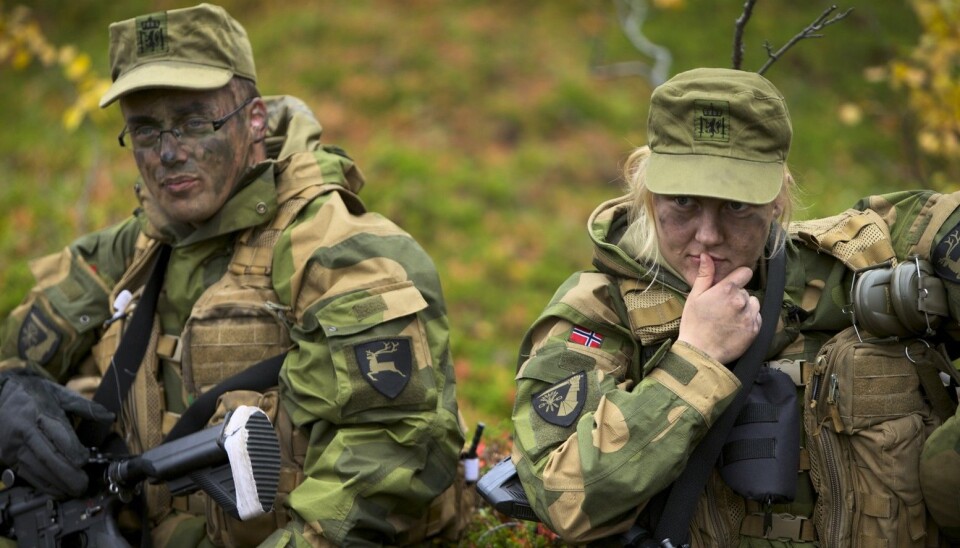An article from KILDEN Information and News About Gender Research in Norway

Unisex rooms in the army take emphasis off gender
A new report on gender equality in the Norwegian Army says that the girls feel less sexually harassed by the boys when they share rooms.
Denne artikkelen er over ti år gammel og kan inneholde utdatert informasjon.
Six boys and two girls in the same room in the army, a place known from previous research as a breeding ground for sexual harassment.
“We were very biased. We thought that the girls could not possibly be OK with it,” says Ulla-Britt Lilleaas, who, together with Dag Ellingsen, is responsible for the report Forsvaret: Likestillingens fortropp, baktropp og kamparena (“The Army: the vanguard, rear guard and battlefield of equality”).
Lilleaas and Ellingsen have studied recruits in the military service who are stationed in Northern Norway.
Degenderising effect
Before their arrival at the camp, some of the girls had thought along the same lines; for instance the girl who had prepared herself by purchasing large sized underwear.

But instead of finding an increased focus on gender and sexuality, the researchers concluded that the unisex rooms had a degenderising effect.
“To them there was nothing strange about the unisex rooms. They had entered a common mode where gender stereotypes had disappeared, or at least they were less obvious. The uniform was also helping as it was more difficult to see the difference between boys and girls,” says Lilleaas.
“There is no gender in the army, there is only green”, said one of the interviewees in the reseach."
Team mentality
The unisex rooms made it possible to focus more on being in the army, said the young people.

At home and at school it was more difficult to be friends with the opposite sex due to all the chatting up, whereas here girls and boys had to become friends.
“You have to be a team here, and then you have to live together in order to be able to trust in one another”, said one of the girls. So it was important that the girls did not form cliques and began slandering, as they had done in school. Unisex rooms were simply a “damn good idea”.
The boys appreciated the fact that it became easier to talk about more important things in life, not only dirty talk, when there were girls present in the rooms.
Motivated girls and boys
Despite the degenderisation, however – most of the girls in the military unit in Northern Norway are afraid that they are not physically adequate. And they are very aware that one girl’s physical defeat affects all of them.
“With every one girl who does not succeed there are probably 20 boys who struggle just as much. But, since there are fewer girls, it becomes more obvious when one has to give up”, Lilleaas says.
Many of the girls believe that the unisex rooms have made it easier to be accepted by the boys.
Both girls and boys adapt
“Is the degenderisation all about adaptable girls becoming ‘one of the boys’?”
The researcher believes that adaptable girls
“That is part of the story, but the boys also adapt to the girls. They are much better at taking showers and cleaning, which is being emphasised as a positive thing by the management,” says Dag Ellingsen.
They are not that preoccupied with gender in the unit in Northern Norway – they are preoccupied with the military service. They have all chosen one of the most challenging educations that the army has to offer, the girls included, who make up 10 per cent of the recruits. Ellingsen believes that this may have had an impact on the positive result.
“In this unit, everybody is very motivated for the military service and making it work is a common project. And the girls in the unit seem well aware of what it takes. ”
Problematic girls’ rooms
Compared to the other army institution which has been studied by the researchers, the contrast is substantial.
In the recruit education unit in the Royal Norwegian Navy, the girls and boys have separate rooms. Here, gender became a significant distinction among the recruits, and the girls’ rooms were particularly considered as problematic. Bitching, slandering and drama was characteristic of the so-called “girl culture”.
“It becomes us and them, us boys against those girls. And we create stereotypes about each other. But these mechanisms become less obvious with the unisex rooms,” says Ellingsen.
Are the girls pepared?
He also suspect the army accept girls who shouldn’t really be there, in order to fulfil political obligations.
“Informants who have been part of the system for a long time have pointed in that direction”.
“Another question is whether the army has sufficiently prepared the girls for what is expected of them. What do they know about the physical demands, about getting out in the woods, carrying heavy loads, freezing? It is not very make-up friendly,”
Pure boys’ rooms, on the other hand, are not considered as being problematic by the researchers.
Harassment in the male bastion
The extensive report on gender in the armed forces was commissioned in order to find so-called “masculinity cultures” which either promote or restrain gender equality in the army.
Many previous studies have shown that the masculine military culture harasses women, who are not considered to belong in this male bastion in the first place.
Not even the recruits in the more or less degenderised unit in the north completely escaped this tradition.
But the only case of harassment which was observed there – when a male recruit tried to destroy a girl’s reputation because she refused his attempt to chat her up – was perceived as unacceptable by the other boys.
The researcher found significantly more examples of sexual harassment and negative masculinity in the navy and in the coastguard. For instance, one set of routines was memorised by the aid of references to the female organs. This was something that the girls figured they just had to put up with.
“They actually didn’t think there was much harassment, they had been prepared for a lot more,” says Lilleaas.
Management responsibility
Lilleaas and Ellingsen are highly critical towards the military rule saying that problems should preferably be solved at the lowest possible level. They believe that this may hinder the work against sexual harassment as the cases are never brought into light and properly handled.
They recommend great caution when introducing unisex rooms in other military units.
“The management in the northern unit was probably decisive for making the experiment such a success. The leader was aware of the girls and paid attention to what went on. His door was always open and he wanted to hear too much rather than too little. There wasn’t much that he wasn’t aware of,” says Lilleaas.
“One need to know what one is doing if this should be introduced. Leaders on all levels must be involved and good report systems are crucial. It might also work better at places where there is a strict selection of recruits,” Ellingsen adds.
He believes that gender neutral military service will give the army the opportunity to select the very best of each gender and thus create a more successful and gender equal army.
“I think there are excellent prerequisites for selecting girls who are highly motivated and competent. Moreover, the army can allow itself to be more selective when picking boys,” Ellingsen says.

































